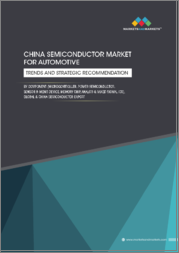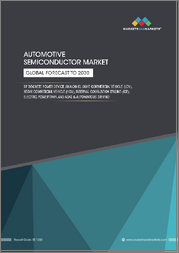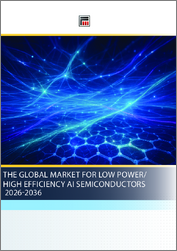
|
시장보고서
상품코드
1759939
중국의 자동차용 반도체 시장 : 컴포넌트별, 세계 반도체 수출 동향, 중국 반도체 수출지별 동향, 전략 제안China Semiconductor Market for Automotive by Component (Microcontroller, Power Semiconductor, Sensor & MEMS Device, Memory Chip, Analog & Mixed Signal IC), Global & China Semiconductor Export, Alternate Destination - Trends and Strategic Recommendation |
||||||
2024년, 중국의 자동차용 반도체의 수출액은 2020년 2,808억 1,000만 달러에서 4,191억 5,000만 달러에 달하며, CAGR은 8.9%로, 자율주행차와 전기자동차의 판매 증가에 의해 촉진되고 있습니다.
중국의 자동차 부문 반도체 시장은 국내 기업과 세계 기업 모두에서 많은 투자를 하고 있으며, SMIC, Huawei's HiSilicon, YMTC, BYD Semiconductor, Tsinghua Unigroup과 같은 대기업이 국내 노력을 주도하고 있습니다. 인텔, 삼성, SK하이닉스 등 세계 기업은 합작투자 및 신규 제조공장을 통해 입지를 확대하고 있습니다. 중국 정부는 자급자족과 완전한 공급망을 실현하기 위해 국가집적회로산업투자기금('빅펀드'), 지방정부 기금, 보조금, 세금 감면, 저금리 대출 등을 통해 시장을 지원하고 있습니다. 첨단 전자제품과 자동차 기술에 대한 세계 수요가 급증하는 가운데, 중국은 홍콩을 무역 허브로 삼아 전 세계에 반도체를 수출하고 있습니다. 전기자동차와 커넥티드카를 중심으로 한 최신 자동차의 등장으로 반도체 수요가 크게 증가하고 있습니다. 이러한 자동차에는 파워트레인 제어, 첨단 운전 보조, 인포테인먼트, 배터리 관리를 위한 첨단 칩이 필요하기 때문입니다. 그 결과, 자동차 부문은 중국 반도체 성장의 중요한 원동력이 되고 있습니다.
메모리 칩은 중국 자동차용 반도체 시장에서 2위를 차지하고 있습니다. 메모리 칩은 AI, 데이터센터, CE(Consumer Electronics), 첨단 자동차 기술에 힘입어 데이터 저장 및 데이터 처리 수요가 급증함에 따라 세계 반도체 산업에서 2위를 차지하고 있습니다. 메모리 칩은 전자기기의 데이터 저장 및 검색에 필수적이며, 용도 실행에서 실시간 시스템 작동에 이르기까지 모든 것을 가능하게 합니다. 이는 인포테인먼트, ADAS, 무인운전 기능 등을 위해 대량의 데이터에 의존하는 현대 자동차에 필수적인 요건입니다. 메모리 칩은 자동차의 하이엔드 인포테인먼트 시스템, ADAS, 디지털 계기판에 광범위하게 사용되고 있습니다. 전기자동차와 자율주행차는 복잡한 컴퓨팅과 데이터 처리로 인해 더 많은 메모리를 필요로 합니다. 중국은 성숙한 노드 칩의 국내 생산을 강화하는 한편, 첨단 메모리 기술, 특히 NAND와 DRAM을 크게 발전시키는데 주력하고 있으며, YMTC와 CXMT와 같은 기업이 그 선두에 서고 있습니다. SMIC는 화웨이의 Mate 60 Pro용 7nm 칩도 생산하고 있습니다.
인도는 세계 2위의 전자기기, 집적회로, 메모리 칩 수입국입니다. 이는 주로 인도의 탄탄한 전자 부문, 디지털화, 대규모 국내 반도체 제조의 부족으로 인해 2024년에는 중국으로부터의 전자 집적회로 수입액만 610만 달러에 달할 것으로 예측됩니다. 이러한 부품은 인포테인먼트, ADAS, 텔레매틱스, 디지털 계기판 등 첨단 기능을 탑재하는 자동차 분야에서 필수적인 부품으로, 방대한 메모리와 처리 능력을 필요로 합니다. 인도의 첨단 자동차 기능 시장은 커넥티비티, 안전, 전동화에 대한 소비자 수요 증가로 인해 빠르게 성장하고 있습니다. 하이브리드 및 전기자동차 신속 도입 및 제조(FAME) 계획과 같은 정부 구상에 힘입어 전기자동차 및 커넥티드카의 도입이 가속화되고 있습니다. 인도의 전자 및 반도체 생태계에 대한 투자도 증가하고 있으며, 국내외 기업이 생산과 연구개발을 확대하고 있습니다. 정부는 전자제품 제조를 위한 생산 연동 인센티브(PLI) 제도와 같은 인센티브 프로그램을 시작했으며, 국내 공급이 부족한 상황에서 수입 메모리와 집적회로에 대한 수요를 더욱 증가시키고 있습니다. 최근 타타 모터스(Tata Motors)와 마힌드라(Mahindra)와 같은 자동차 제조업체들이 최신 모델에 첨단 전자제품을 탑재하고 있으며, 이는 인도 자동차 및 전자제품 부문의 기술 주도 성장이라는 광범위한 추세를 반영하고 있습니다.
이 보고서는 마이크로컨트롤러, 전력반도체, 센서 및 MEMS 디바이스, 메모리칩, 아날로그 및 혼합신호 집적회로 등 다양한 유형에 초점을 맞추어 중국의 자동차용 반도체 시장을 상세하게 분석했습니다. 수출 동향, 무역 정책 및 규제의 영향, 중국으로부터의 반도체 산업 다각화도 검토하고 있습니다. 또한 대체 생산지에 대해서도 조사하고, 전환에 따른 과제와 전략과 함께 이들 지역의 비교 분석도 함께 진행합니다.
또한 세계 자동차 부문이 반도체 시장에 미치는 영향을 평가하고 향후 전망을 제시합니다. 중국 반도체 시장의 성장을 가속하는 주요 요인에 대한 자세한 정보도 제공합니다. 주요 업계 참여업체에 대한 철저한 분석을 통해 사업 개요, 제품 제공, 주요 전략, 계약, 파트너십, 협정, 신제품 발표, 합병, 인수합병에 대한 인사이트를 제공합니다.
이 보고서는 중국 자동차용 반도체 시장 전체와 그 하위 부문 시장 매출 추정에 관한 시장 리더와 신규 시장 진출기업에게 귀중한 정보를 제공합니다. 이해관계자들이 경쟁 구도를 이해하고, 사업을 보다 효과적으로 포지셔닝하고, 적절한 시장 진출 전략을 계획하는 데 도움이 될 것입니다. 또한 이 보고서는 현재 시장 상황에 대한 인사이트를 제공하고, 업계내 주요 촉진요인, 억제요인, 과제 및 기회를 강조합니다.
목차
제1장 서론
제2장 중국의 자동차용 반도체 산업
- 중국의 자동차용 반도체의 현황
- 마이크로컨트롤러
- 파워 반도체
- 센서와 MEMS
- 메모리 칩
- 아날로그 및 혼합 신호 집적회로
- 시장가치 평가
제3장 중국 자동차용 반도체 산업의 주요 참여 기업
- 국내 제조업체
- SMIC
- GIGADEVICE
- NOVOSENSE MICROELECTRONICS
- SILAN MICROELECTRONICS
- HISILICON
- HUA HONG SEMICONDUCTOR LIMITED
- BYD SEMICONDUCTOR
- NEXPERIA
- CHANGXIN MEMORY TECHNOLOGIES
- YANGTZE MEMORY TECHNOLOGIES CORP
- GOERTEK MICROELECTRONICS INC.
- CHINA RESOURCES MICROELECTRONICS LIMITED
- HESAI TECHNOLOGY
- 기타
- 중국에서의 세계 제조업체
- NXP SEMICONDUCTORS
- INFINEON TECHNOLOGIES
- STMICROELECTRONICS
- TEXAS INSTRUMENTS
- RENESAS ELECTRONICS CORPORATION
- 합병사업과 전략적 파트너십
제4장 중국의 자동차용 반도체의 수출 분석
- 주요 수출 제품 카테고리
- 세계의 반도체 수출
- 중국으로부터의 수출
제5장 중국 자동차용 반도체 산업의 다양화
- 지정학적 요인
- 공급망 레질리언스 전략
- 경제적 요인
- 세계의 자동차 산업에 대한 영향
제6장 대체 제조 기반
- 개요
- 대체 제조 기반의 비교 분석
- 국가/지역별 기술 우위성
- 동남아시아
- 말레이시아
- 베트남
- 태국
- 싱가포르
- 한국
- 대만
- 북미
- 유럽
- 인도
제7장 향후 전망과 제안
- 2025-2030년 예측 산업 시프트
- 기술 로드맵
- 업계 이해관계자에 대한 전략적 제안
In 2024, China's exports of automotive semiconductors reached USD 419.15 billion in 2024, from USD 280.81 billion in 2020, with a CAGR of 8.9%, driven by increased sales of autonomous and electric vehicles.
China's semiconductor market for the automotive sector is experiencing substantial investment from both domestic and global companies. Major players such as SMIC, Huawei's HiSilicon, YMTC, BYD Semiconductor, and Tsinghua Unigroup are leading domestic efforts, while international firms like Intel, Samsung, and SK Hynix are expanding their presence through joint ventures and new fabrication plants. The Chinese government supports the market with the National Integrated Circuit Industry Investment Fund ("Big Fund"), local government funds, subsidies, tax breaks, and low-interest loans, all aimed at achieving self-sufficiency and a complete supply chain. As global demand for advanced electronics and automotive technologies surges, China exports semiconductors worldwide, often using Hong Kong as a trade hub. The rise of modern vehicles, primarily electric and connected cars, has significantly increased the demand for semiconductors, as these vehicles require advanced chips for powertrain control, advanced driver assistance, infotainment, and battery management. Consequently, the automotive sector has become a key driver of semiconductor growth in China.
Memory chips are the second-largest segment in China's automotive semiconductor market.
Memory chips rank second in the Chinese automotive semiconductor market. These chips also hold the second-largest position in the global semiconductor industry due to soaring demand for data storage and processing, driven by AI, data centers, consumer electronics, and advanced automotive technologies. Memory chips are vital for storing and retrieving data in electronic devices, enabling everything from application execution to real-time system operations-an essential requirement for modern vehicles that rely on significant amounts of data for infotainment, ADAS, and autonomous driving features. Memory chips are extensively used in high-end infotainment systems, ADAS, and digital instrument clusters in cars. Electric and autonomous vehicles demand even more memory due to their complex computing and data processing needs. China is focusing on boosting domestic production of mature-node chips while also making significant advancements in advanced memory technology, particularly in NAND and DRAM, with companies like YMTC and CXMT leading the way. YMTC has developed advanced 3D TLC NAND chips that compete with global leaders like Samsung and Micron, while CXMT has produced and released G4 DDR5 DRAM. SMIC has also manufactured 7 nm chips for Huawei's Mate 60 Pro.
India is the second-largest importer of semiconductors from China.
India is the second-largest importer of electronics, integrated circuits, and memory chips worldwide. This is primarily due to the country's robust electronics sector, digitalization, and the lack of large-scale domestic semiconductor manufacturing. In 2024, imports of electronic integrated circuits from China alone reached USD 6.1 million. These components are essential in the automotive sector for advanced features such as infotainment, ADAS, telematics, and digital instrument clusters, which require significant memory and processing power. The Indian market for advanced automotive features is rapidly growing, driven by rising consumer demand for connectivity, safety, and electrification. The adoption of EVs and connected cars is accelerating, supported by government initiatives like the Faster Adoption and Manufacturing of Hybrid and Electric Vehicles (FAME) scheme. Investment in India's electronics and semiconductor ecosystem is also on the rise, with both domestic and international companies expanding production and R&D. The government has launched incentive programs such as the Production-Linked Incentive (PLI) scheme for electronics manufacturing, further increasing demand for imported memory and integrated circuits as local supply struggles to keep pace. Recent examples include automakers like Tata Motors and Mahindra integrating more sophisticated electronics into their latest models, reflecting the broader trend of technology-driven growth in India's automotive and electronics sectors.
Research Coverage:
The report provides an in-depth analysis of the China semiconductor market for automotive, focusing on various types, including microcontrollers, power semiconductors, sensors & MEMS devices, memory chips, and analog & mixed-signal integrated circuits. It examines export trends, the impact of trade policies and restrictions, and the diversification of the semiconductor industry away from China. The report also explores alternative manufacturing destinations, offering a comparative analysis of these locations, along with the challenges and strategies associated with the transition.
Additionally, the report assesses the effects of the global automotive sector on the semiconductor market and presents a future outlook. It includes detailed information about the major factors driving growth in China's semiconductor market. A thorough analysis of key industry players provides insights into their business overviews, product offerings, key strategies, contracts, partnerships, agreements, new product launches, mergers, and acquisitions.
Key Benefits of Buying this Report:
The report provides valuable information for market leaders and new entrants regarding revenue estimates for both the overall automotive semiconductor market in China and its sub-segments. It will assist stakeholders in understanding the competitive landscape, positioning their businesses more effectively, and planning appropriate go-to-market strategies. Additionally, the report offers insights into the current market conditions and highlights key drivers, restraints, challenges, and opportunities within the industry.
The report provides insights into the following points:
- Analysis of critical drivers (increased domestic investments in semiconductors), restraints (shortage of manufacturing facilities for 12 mm machines), opportunities (substantial investments by <12-inch wafer manufacturers), and challenges (technological gap) influencing the growth of the China semiconductor market for automotive
- Product Development/Innovation: Detailed insights into upcoming technologies and new products launched in the China semiconductor market for automotive
- Market Development: Comprehensive market information - the report analyses the authentication and brand protection market across Chinese countries
- Market Diversification: Exhaustive information about new products & services, untapped geographies, recent developments, and investments in the China semiconductor market for automotive
- Competitive Assessment: In-depth assessment of market shares, growth strategies, and service offerings of leading players, such as SMIC, GigaDevice Semiconductor Inc., Novosense Microelectronics, Silan Microelectronics, and HiSilicon
TABLE OF CONTENTS
1 INTRODUCTION
- 1.1 GLOBAL AUTOMOTIVE SEMICONDUCTOR INDUSTRY OVERVIEW
- 1.2 HISTORICAL DEVELOPMENT OF CHINA AUTOMOTIVE SEMICONDUCTOR INDUSTRY
- 1.2.1 2010-2014
- 1.2.2 2015-2020
- 1.2.3 2021-2025
- 1.3 KEY FACTORS DRIVING INDUSTRY SHIFT FROM CHINA
- 1.3.1 REGULATORY FACTORS
- 1.3.1.1 Restrictive controls by US government
- 1.3.1.2 Chips Act and other global legislation
- 1.3.1.3 National security concerns
- 1.3.2 GEOPOLITICAL FACTORS
- 1.3.2.1 Taiwan Strait tensions
- 1.3.2.2 Russia-Ukraine war
- 1.3.2.3 Technology alliances
- 1.3.2.4 Technology limitations
- 1.3.3 ECONOMIC AND SUPPLY CHAIN FACTORS
- 1.3.3.1 Rising manufacturing costs in China
- 1.3.3.2 Incentives from alternative locations
- 1.3.4 CHALLENGES
- 1.3.4.1 Dependency on foreign IP & architecture and gaps in certification
- 1.3.4.2 Heavy reliance on imported semiconductor manufacturing equipment
- 1.3.1 REGULATORY FACTORS
2 CHINA AUTOMOTIVE SEMICONDUCTOR INDUSTRY
- 2.1 CURRENT STATE OF CHINA'S AUTOMOTIVE SEMICONDUCTORS
- 2.1.1 MICROCONTROLLERS
- 2.1.1.1 Key manufacturers, core competencies, and production capacities
- 2.1.1.2 Future roadmap
- 2.1.2 POWER SEMICONDUCTORS
- 2.1.2.1 Key manufacturers, core competencies, and production capacities
- 2.1.2.2 Future roadmap
- 2.1.3 SENSORS & MEMS
- 2.1.3.1 Key manufacturers, core competencies, and production capacities
- 2.1.3.2 Future roadmap
- 2.1.4 MEMORY CHIPS
- 2.1.4.1 Key manufacturers, core competencies, and production capacities
- 2.1.4.2 Future roadmap
- 2.1.5 ANALOG & MIXED-SIGNAL INTEGRATED CIRCUITS
- 2.1.5.1 Key manufacturers, core competencies, and production capacities
- 2.1.5.2 Future roadmap
- 2.1.1 MICROCONTROLLERS
- 2.2 MARKET VALUE ASSESSMENT
3 KEY PLAYERS IN CHINA AUTOMOTIVE SEMICONDUCTOR INDUSTRY
- 3.1 DOMESTIC MANUFACTURERS
- 3.1.1 SMIC
- 3.1.1.1 Overview
- 3.1.1.2 Recent financials
- 3.1.1.3 Production plants and capacity
- 3.1.1.4 Future strategy
- 3.1.2 GIGADEVICE
- 3.1.2.1 Overview
- 3.1.2.2 Recent financials
- 3.1.2.3 Production plants and capacity
- 3.1.2.4 Future strategy
- 3.1.3 NOVOSENSE MICROELECTRONICS
- 3.1.3.1 Overview
- 3.1.3.2 Recent financials
- 3.1.3.3 Production plants and capacity
- 3.1.3.4 Future strategy
- 3.1.4 SILAN MICROELECTRONICS
- 3.1.4.1 Overview
- 3.1.4.2 Recent financials
- 3.1.4.3 Production plants and capacity
- 3.1.4.4 Future strategy
- 3.1.5 HISILICON
- 3.1.5.1 Overview
- 3.1.5.2 Recent financials
- 3.1.5.3 Production plants and capacity
- 3.1.5.4 Future strategy
- 3.1.6 HUA HONG SEMICONDUCTOR LIMITED
- 3.1.6.1 Overview
- 3.1.6.2 Recent financials
- 3.1.6.3 Production plants and capacity
- 3.1.6.4 Future strategy
- 3.1.7 BYD SEMICONDUCTOR
- 3.1.7.1 Overview
- 3.1.7.2 Recent financials
- 3.1.7.3 Production plants and capacity
- 3.1.7.4 Future strategy
- 3.1.8 NEXPERIA
- 3.1.8.1 Overview
- 3.1.8.2 Recent financials
- 3.1.8.3 Production plants and capacity
- 3.1.8.4 Future strategy
- 3.1.9 CHANGXIN MEMORY TECHNOLOGIES
- 3.1.9.1 Overview
- 3.1.9.2 Recent financials
- 3.1.9.3 Production plants and capacity
- 3.1.9.4 Future strategy
- 3.1.10 YANGTZE MEMORY TECHNOLOGIES CORP
- 3.1.10.1 Overview
- 3.1.10.2 Recent financials
- 3.1.10.3 Production plants and capacity
- 3.1.10.4 Future strategy
- 3.1.11 GOERTEK MICROELECTRONICS INC.
- 3.1.11.1 Overview
- 3.1.11.2 Recent Financials
- 3.1.11.3 Production plants and capacity
- 3.1.11.4 Future strategy
- 3.1.12 CHINA RESOURCES MICROELECTRONICS LIMITED
- 3.1.12.1 Overview
- 3.1.12.2 Recent financials
- 3.1.12.3 Production plants and capacity
- 3.1.12.4 Future strategy
- 3.1.13 HESAI TECHNOLOGY
- 3.1.13.1 Overview
- 3.1.13.2 Recent financials
- 3.1.13.3 Production plants and capacity
- 3.1.13.4 Future strategy
- 3.1.14 OTHERS
- 3.1.1 SMIC
- 3.2 GLOBAL MANUFACTURERS IN CHINA
- 3.2.1 NXP SEMICONDUCTORS
- 3.2.1.1 Overview
- 3.2.1.2 Recent financials
- 3.2.1.3 Production plants and capacity
- 3.2.1.4 Future strategy
- 3.2.2 INFINEON TECHNOLOGIES
- 3.2.2.1 Overview
- 3.2.2.2 Recent financials
- 3.2.2.3 Production plants and capacity
- 3.2.2.4 Future strategy
- 3.2.3 STMICROELECTRONICS
- 3.2.3.1 Overview
- 3.2.3.2 Recent financials
- 3.2.3.3 Production plants and capacity
- 3.2.3.4 Future strategy
- 3.2.4 TEXAS INSTRUMENTS
- 3.2.4.1 Overview
- 3.2.4.2 Recent financials
- 3.2.4.3 Production plants and capacity
- 3.2.4.4 Future strategy
- 3.2.5 RENESAS ELECTRONICS CORPORATION
- 3.2.5.1 Overview
- 3.2.5.2 Recent financials
- 3.2.5.3 Production plants and capacity
- 3.2.5.4 Future strategy
- 3.2.1 NXP SEMICONDUCTORS
- 3.3 JOINT VENTURES AND STRATEGIC PARTNERSHIPS
4 EXPORT ANALYSIS OF CHINA'S AUTOMOTIVE SEMICONDUCTORS
- 4.1 KEY EXPORT PRODUCT CATEGORIES
- 4.2 GLOBAL SEMICONDUCTOR EXPORTS
- 4.2.1 ELECTRONIC INTEGRATED CIRCUITS (HS CODE 854231)
- 4.2.2 ELECTRONIC INTEGRATED CIRCUITS AS MEMORIES (HS CODE 854232)
- 4.2.3 ELECTRONIC INTEGRATED CIRCUITS AS AMPLIFIERS (HS CODE 854233)
- 4.2.4 ELECTRONIC INTEGRATED CIRCUITS (EXCL. PROCESSORS, CONTROLLERS, MEMORIES, AND AMPLIFIERS) (HS CODE 854239)
- 4.2.5 PARTS OF ELECTRONIC INTEGRATED CIRCUITS (HS CODE 854290)
- 4.3 EXPORTS FROM CHINA
- 4.3.1 ELECTRONIC INTEGRATED CIRCUITS (HS CODE 854231)
- 4.3.1.1 China
- 4.3.1.2 Hong Kong, China
- 4.3.2 ELECTRONIC INTEGRATED CIRCUITS AS MEMORIES (HS CODE 854232)
- 4.3.2.1 China
- 4.3.2.2 Hong Kong, China
- 4.3.3 ELECTRONIC INTEGRATED CIRCUITS AS AMPLIFIERS (HS CODE 854233)
- 4.3.3.1 China
- 4.3.3.2 Hong Kong, China
- 4.3.4 ELECTRONIC INTEGRATED CIRCUITS (EXCL. PROCESSORS, CONTROLLERS, MEMORIES, AND AMPLIFIERS) (HS CODE 854239)
- 4.3.4.1 China
- 4.3.4.2 Taipei, China
- 4.3.4.3 Hong Kong, China
- 4.3.1 ELECTRONIC INTEGRATED CIRCUITS (HS CODE 854231)
5 DIVERSIFICATION OF CHINA AUTOMOTIVE SEMICONDUCTOR INDUSTRY
- 5.1 GEOPOLITICAL FACTORS
- 5.1.1 US-CHINA TRADE TENSIONS
- 5.1.1.1 US-China tariffs
- 5.1.1.2 Diversification strategies
- 5.1.2 TECHNOLOGY EXPORT CONTROLS
- 5.1.2.1 US & Chinese technology export controls
- 5.1.2.2 Impact of export controls
- 5.1.3 NATIONAL SECURITY CONCERNS
- 5.1.1 US-CHINA TRADE TENSIONS
- 5.2 SUPPLY CHAIN RESILIENCE STRATEGIES
- 5.2.1 KNOWLEDGE GAINED FROM COVID-19 PANDEMIC
- 5.2.1.1 Realization by China after Covid-19
- 5.2.1.2 Impact on global players
- 5.2.1.3 Shift from JIT to strategic resilience
- 5.2.1 KNOWLEDGE GAINED FROM COVID-19 PANDEMIC
- 5.3 ECONOMIC FACTORS
- 5.3.1 RISING MANUFACTURING COSTS IN CHINA
- 5.3.1.1 Cost comparison
- 5.3.1.2 Bill of Materials
- 5.3.2 INCENTIVE PROGRAMS IN ALTERNATIVE LOCATIONS
- 5.3.1 RISING MANUFACTURING COSTS IN CHINA
- 5.4 IMPACT ON GLOBAL AUTOMOTIVE INDUSTRY
- 5.4.1 EFFECTS ON AUTOMOTIVE PRODUCTION COSTS
- 5.4.2 SUPPLY CHAIN RELIABILITY AND RESILIENCE
- 5.4.3 REGIONAL MANUFACTURING CLUSTERS
- 5.4.4 TECHNOLOGY DEVELOPMENT AND INNOVATION PATTERNS
6 ALTERNATIVE MANUFACTURING DESTINATIONS
- 6.1 OVERVIEW
- 6.2 COMPARATIVE ANALYSIS OF ALTERNATIVE MANUFACTURING LOCATIONS
- 6.2.1 RANKING AS ALTERNATIVES TO CHINA
- 6.3 TECHNOLOGY DOMINANCE, BY COUNTRY/REGION
- 6.4 SOUTHEAST ASIA
- 6.4.1 MALAYSIA
- 6.4.1.1 Government incentives and support
- 6.4.1.2 Key diversifications
- 6.4.1.3 Challenges
- 6.4.2 VIETNAM
- 6.4.2.1 Government incentives and support
- 6.4.2.2 Key diversifications
- 6.4.2.3 Challenges
- 6.4.3 THAILAND
- 6.4.3.1 Government incentives and support
- 6.4.3.2 Key diversifications
- 6.4.3.3 Challenges
- 6.4.4 SINGAPORE
- 6.4.4.1 Government incentives and support
- 6.4.4.2 Key diversifications
- 6.4.4.3 Challenges
- 6.4.5 SOUTH KOREA
- 6.4.5.1 Government incentives and support
- 6.4.5.2 Key diversifications
- 6.4.5.3 Impact of key players
- 6.4.5.3.1 Samsung
- 6.4.5.3.2 SK Hynix
- 6.4.5.4 Challenges
- 6.4.6 TAIWAN
- 6.4.6.1 Government incentives and support
- 6.4.6.2 Key diversifications
- 6.4.6.3 Impact of key players
- 6.4.6.3.1 TSMC
- 6.4.6.4 Challenges
- 6.4.1 MALAYSIA
- 6.5 NORTH AMERICA
- 6.5.1 GOVERNMENT INCENTIVES AND SUPPORT
- 6.5.2 KEY DIVERSIFICATIONS
- 6.5.2.1 US
- 6.5.2.2 Mexico
- 6.5.3 CHALLENGES
- 6.6 EUROPE
- 6.6.1 INCENTIVES BY EUROPEAN COUNTRIES
- 6.6.1.1 Germany
- 6.6.1.2 France
- 6.6.1.3 Italy
- 6.6.2 EUROPEAN MANUFACTURING HUBS
- 6.6.1 INCENTIVES BY EUROPEAN COUNTRIES
- 6.7 INDIA
- 6.7.1 GOVERNMENT INCENTIVES AND SUPPORT
- 6.7.2 KEY DIVERSIFICATIONS
- 6.7.3 CHALLENGES
7 FUTURE OUTLOOK AND RECOMMENDATIONS
- 7.1 PROJECTED INDUSTRY SHIFTS, 2025-2030
- 7.2 TECHNOLOGY ROADMAP
- 7.3 STRATEGIC RECOMMENDATIONS FOR INDUSTRY STAKEHOLDERS
- 7.3.1 DIVERSIFICATION
- 7.3.2 TECHNOLOGY
- 7.3.3 SUPPLY CHAIN



















